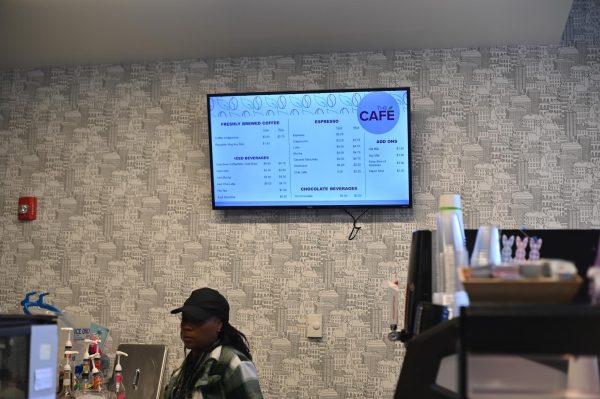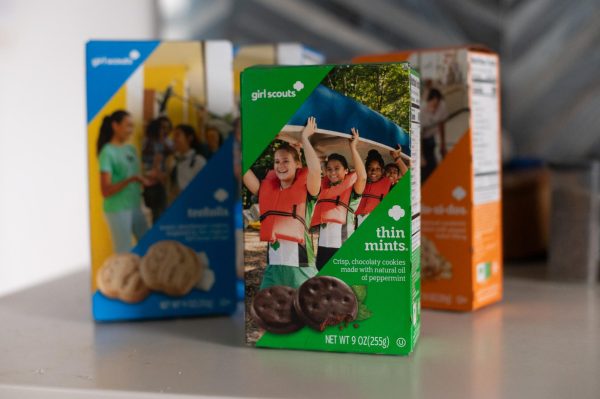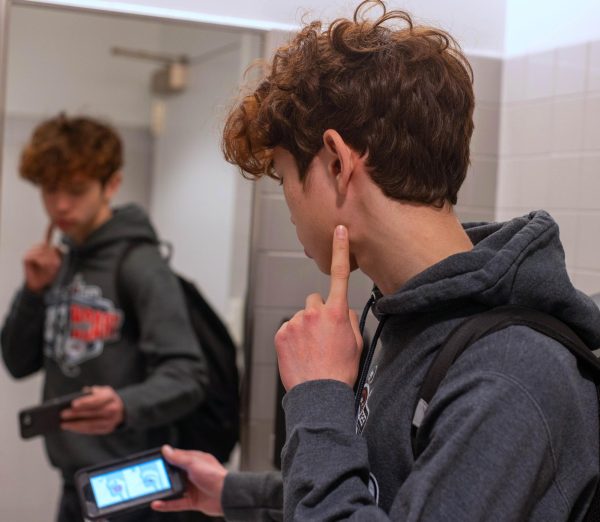‘Fortnite’ draws non-gamers, entering mainstream
May 29, 2018

HALLWAY GAMING. Beginning her game of “Fortnite Battle Royale” by gliding down to the surface, junior Aly Latherow plays in the junior hallway during open time May 22. Players were able to register for “Fortnite” on iOS beginning March 12.
Junior Marc Mulligan plays “Fortnite” for four hours a day on average, and last month at Junior Retreat, he wanted to continue playing, so he brought his Xbox. But he needed a TV to play.
“It comes time when they want us to turn the lights off, and then I come back into our little cabin, and people are talking to me like. ‘Oh did you find anything,’ and I’m like, ‘No, and I have a raging ‘Fortnite’ addiction and I lugged 15 pounds of Xbox up here, and I can’t find a freaking TV,’” Marc said.
But Marc is not the only one who plays “Fortnite” regularly.
“Fortnite” is a third-person shooter similar to “Player Unknown Battlegrounds,” except players can build walls, floors and roofs — the components of a fort — during a match to create barricades or traverse difficult terrain.
The game has spread like wildfire through the U-High community because of the qualities that make the game so addictive: creativity, self-reliance and variability. It has even begun attracting celebrities to join in — Drake, recognizing the economic potential, played with a popular Twitch streamer, Ninja.
Developed by Epic Games, “Fortnite” was released July 17, 2017, but didn’t become popular until a free “Battle Royale” game mode came out Sept. 26, 2017. The purpose of the “Battle Royale” mode is to be the last player standing among 100 rivals — or the last group if playing in squad mode, where players compete in groups of four or fewer. Players travel around the map, collecting guns, materials for fort-building and medical supplies. They must take care to stay within the eye of the storm — a circle that shrinks as the game progresses, forcing players closer to one another until a final showdown.

“Battle Royale” has made the game incredibly popular. According to a Chicago Tribune article, “‘Fortnite’ generated $223 million in revenue across all platforms in March, up 73 percent from February, according to game researcher SuperData.” While this version of the game is free to play, Epic Games makes money from selling skins — costumes for players’ characters.
Kendrick Xie, a sophomore who streams his “Fortnite” gameplay on Twitch, thinks of “Fortnite” as a gateway game.
“A lot of people didn’t even play video games before ‘Fortnite,’ but now people from school and a bunch of people on my swim team play it, too,” he said.
Besides the fort-building and and loot-collecting, Kendrick said the long breaks between action bring people together.
I come back into our little cabin, … I’m like, ‘No, and I have a raging ‘Fortnite’ addiction and I lugged 15 pounds of Xbox up here, and I can’t find a freaking TV. — Marc Mulligan, Junior
“Just like one of your friends is playing some other guy that you don’t talk to much, and you just join him, and then you get to know the other guy,” Kendrick said.
Gabe Fioramonti-Gorchow, a junior player, said the game is easy to get into.
“They’re quick games. You can leave whenever. Every game has a clear winner. No two games are the same,” Gabe said. “You’re gonna get new guns, loot, and you can be really creative with your building.”
Those who play regularly seem to play quite a lot. Marc and Gabe agreed that the game can be incredibly addictive.
“It’s kind of addicting, to be honest, “Gabe said. “Sometimes I’m not even enjoying it, and I’ll still keep playing.”
Marc said the game has spread quickly because of its target market.
“One of the biggest things that has helped ‘Fortnite’ is just the infective matter of its popularity,” Marc said. “With their main market, teenagers and young children, a major thing is the influence of your peers. If your friends play it, you’re probably gonna end up playing it too.”

















